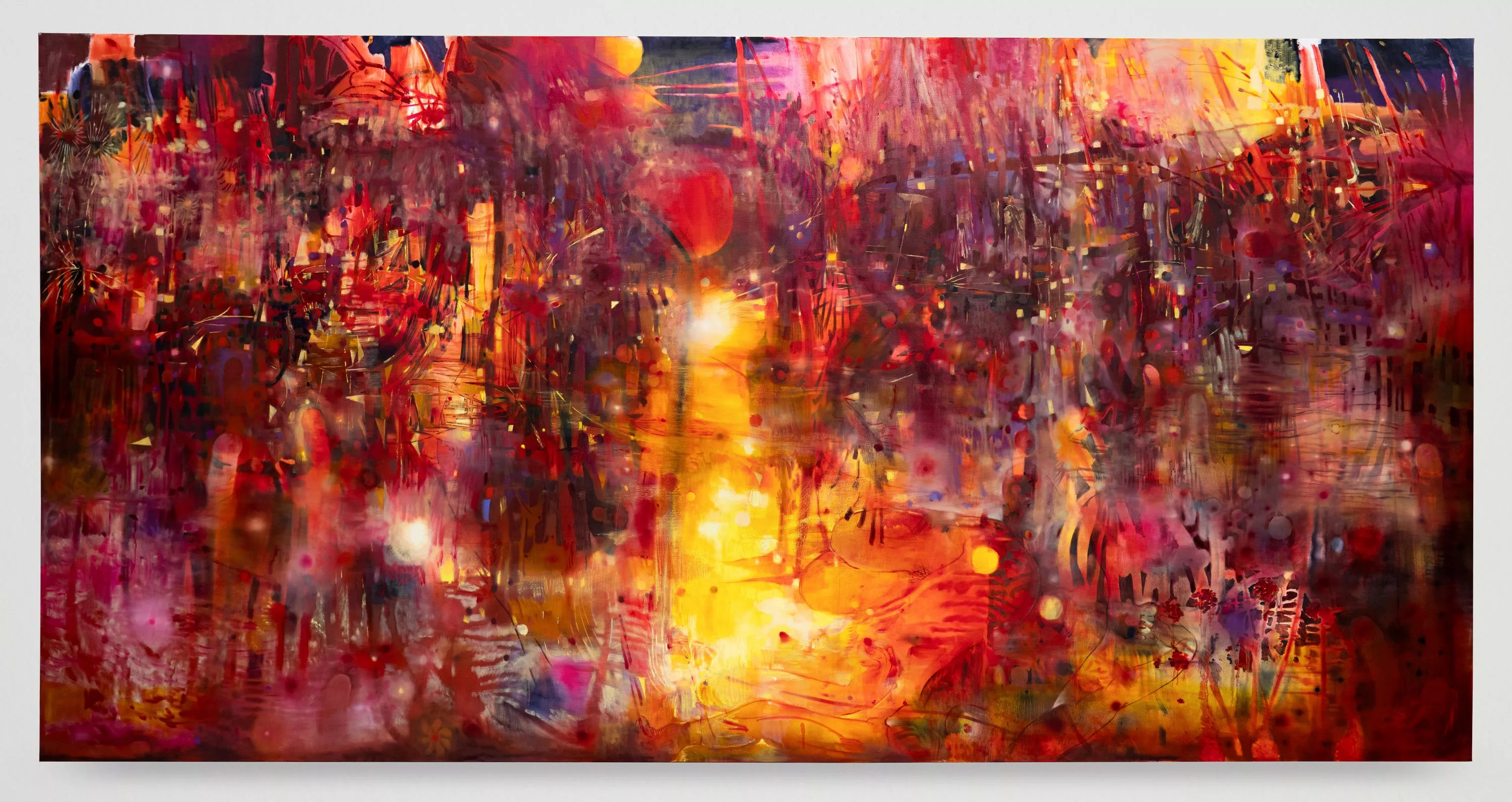
In Li Hei Di’s latest exhibition there’s a work she refers to as “the big red painting.” Occupying an entire wall in the intimate rooms of the Pippy Houldsworth Gallery, the “big red painting” hums with energy. Measuring almost four metres in length and two metres in height, it is a work that exults in its own redness, burning crimson, carmine, vermillion and maroon into orange and gold. Worlds emerge and converge on its surface; fissions and collisions of charged reds simultaneously reverb away then into each other. The work not only captures light but almost catches on fire, as scarlet embers smoulder into lucent yellows. This “big red painting”, a star in its own right, never fails to pull you into its orbit, leaving you wondering whether you’re in the centre of some ancient sun or positioned on its photospheric periphery.
Privately dubbed “the big red painting”, the work is in fact called I’m not ready to be born a child again (2024). While a naissance of some kind does occur within its shimmering veils of paint, “the big red painting” is neither inspired by a star nor the possibility of nativity. Rather, it is entirely beholden to the various shades, realities and fantasies of its own paint. “I wanted to paint it that colour because when I close my eyes I see red,” Li explains to me over Zoom. “It was also inspired by a song from Lou Ye’s film Blind Massage,” she continues. “I really love the film. It’s about a group of young people who are blind and work as masseurs. There’s a song at the end and the lyrics are something along the lines of, ‘Mama, I fell in love with a girl, she ate my eyes and all I can see is red.’ Those lyrics really spoke to me. I made the big red painting and in doing so understood what they meant. That, and I just wanted to create a painting where all people see is red.”
Red is certainly all that viewers see in I’m not ready to be born a child again, but it’s a colour inflected by the vision of Ye’s blind protagonists. It’s a red that precedes sight whilst testifying to the erotics of it. And it’s a personal red stripped of the political and cultural symbolism that at once deems the shade transgressive and traditional, raw and regal. It is also a red that encapsulates themes, ideas and processes integral to the paintings exhibited in Li’s current show, 700 Nights of Winter, as well as her wider body of work. When looking at I’m not ready to be born a child again, Li’s exploration and recreation of intimacy – emotional, sexual, social, artistic and aesthetic – comes to the fore. In addition to Ye’s award-winning film, the early cinema of Hong Kong and works by the likes of auteur-director Wong Kar Wei also inspire the artist’s palette (the deep tones and vibrant red curtains evinced within In the Mood for Love could easily have been a source of inspiration). Philosophical texts on the erotic and pornographic by Byung-Chul Han and Paul B. Preciado, as well as works on queer subjectivities, identities and sexualities by the likes of bell hooks, Maggie Nelson and Virginia Woolf, are also invoked by Li’s work. Although her art does not directly stem from these texts, it does bear a trace of their influence, and Li in part reapplies and renegotiates their ideas on freedom and desire in her own daring red marks. Thus, paintings like I’m not ready to be born a child again, where feelings swell and passions throb, allow us to reconsider and reformulate what love, the erotic and an ethic of sensuality could look, feel and be like.

Known for her multidisciplinary practise that spans video, sculpture and performance, Li’s painting has always been associated with feeling. Long before receiving her MA from the Royal College of Art and BA at Chelsea College of Arts – the latter an environment that “encouraged works with different materials rather than just traditional painting,” Li observes – painting was a private past time, one which allowed her “to express a lot” and “saved” her during her teenage and childhood years, but it was not at the forefront of her practise. Ever one to relish the opportunity to build sculptures and literally get stuck into materials with her hands – “I love every form of artmaking” insists Li – painting became the one mode that posed – and continues to pose – a serious challenge. “I always felt like painting was something truly ancient. In a way it’s selfish, because it’s therapeutic; the physical act of moving the paint on the surface of the canvas is healing. But painting as a medium is easy and hard at the same time. It’s easy because anyone can paint; it’s hard because it has this long history dating back to the prehistoric era. In light of this tradition, what does painting mean now? What makes a good painting today? How does one go about creating a good painting after so many people have already created such good paintings? Now that’s an interesting challenge!”
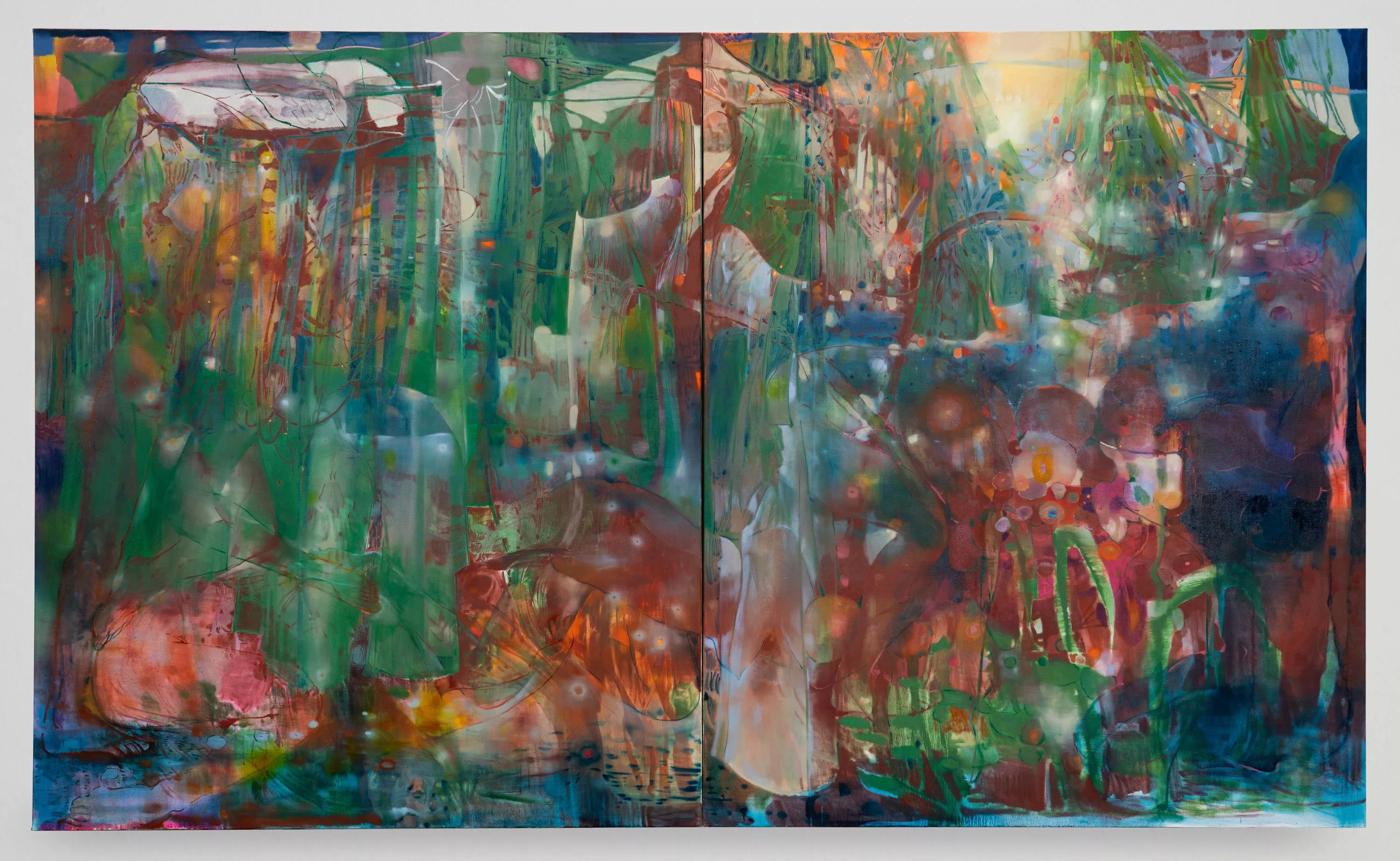
Reflecting on the sheer scale and power and sensibility of I’m not ready to be born a child again, I tell Li that she has more than risen to this challenge. Even when comparing it with other renowned works of red (such as Rothko’s Untitled (Red), 1956, and his other various ‘red’ paintings, Matisse’s Red Room (Harmony in Red),1908, and the lesser-known but equally special Desert Moon, 1955, by Lee Krasner), Li’s painting holds its own. What makes this a “good painting,” to use the Li’s own phrase, is its mastering of a hue from which many artists would shy away. Unlike her slightly smaller though no less impressive works included in the exhibition, I’m not ready to be born a child again engulfs you whole – but it does so surreptitiously, sensuously, slowly, and, in the viewer’s case, willingly. Inspiring a kind of religious or spiritual awe with its baroque folds and rivulets of reds, I’m not ready to be born a child again transforms you emotionally whilst transcending any simple theoretical characterisation and aesthetic categorisation. It is a “good painting” precisely because it grandly “challenges” our preconceptions of what paintings can be and do, all the while affectively arresting our attention. This is the erotics upon which all of Li’s paintings operate; whereby the act of looking becomes one of feeling and being, knowing and communing, not merely judging or consuming.
As if to mirror this erotics of looking, Li’s paintings at once reveal and conceal their hidden natures and inner beings. 700 Nights of Winter – a seductive title in and of itself, with its cited seasonal coldness intimately implying its warm opposite – offers nine other works besides the “big red painting” that are as erotic in form as they are in theory. Under shales and peals of luminescent paint we espy entwined limbs, the outline of a thigh wrapped around another, the lithe lineaments of an arm, leg or spine dissolving into the scintillating, undulating body of the works. Glimpses of these partially shaded contours of desire mimic our own act of looking and undressing of the image – and, to an extent, being undressed by it too. Bodies submerge and emerge in the cosmic expanse of their canvasses, softening the line between part and whole, inner and outer, the human composition and that of the painting entire. In Breast to Breast I Face Your Hunger (2024), human forms somersault one into the other in a cascade of blushing pinks and violets, bashful blues and mauves. Acting as a distillation or conflation of skin to skin moments in a confetti of bluesy bi-colours, Breast to Breast I Face Your Hunger becomes a sort jouissance (a form of bliss), as Roland Barthes would term it, of simultaneous overlappings and meetings and partings; a coalescence of tone and shape, sense and the singular syntax of Li’s paint. Beneath a blue depth in the lower half of the painting, part of a pale pink torso sinks – or rises – enveloped in and enveloping the bluish, pinkish baptismal pool. Saturated, the part-body drowns in its encounter with something beyond, yet very much of, itself. Where the corporeal begins and the incorporeal ends is uncertain, as the various liquid affinities and blissed-out bodily proximities blur. What Li achieves in this and many of her works is an oceanic state in an oneiric space; a blissfully and subversively unsteady zone where the erotic and ecstatic are open-ended – and open to us too.
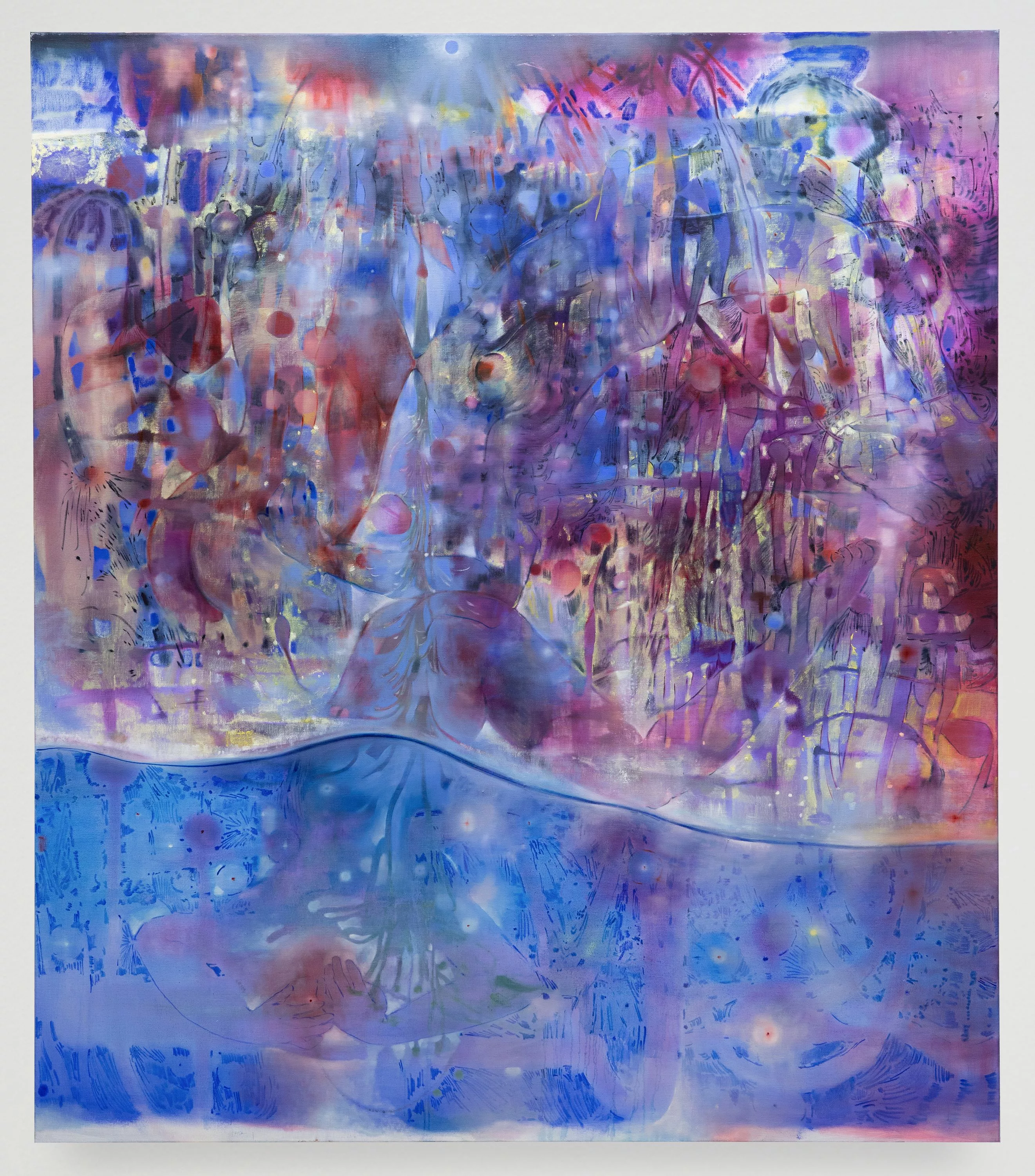
This fluidity and unbounded sense of being in Li’s work also extends to her sense of process. Indeed, Li compares the experience of painting to “trying to take a stone from the bottom of a lake.” Entering into a “different emotional space” in order to create her paintings, the artist says the process feels “almost spiritual. As if I’m a medium receiving all this information from the universe. All these figures and marks in the painting are not planned; it’s as if they were already there. It feels like something is trying to emerge from water.” At once channelling and diving into the unknown, Li’s works are fluid in theme as well as style. In fact, fluidity becomes the unacknowledged ruling principle of recent works like Breast to Breast I Face Your Hunger and House of Small Offerings (2024) as well as earlier paintings like Liquid Meadow (2022) and Unmotherly Sea of Winter (2022). Whilst in earlier works anemone-like flourishes, tinges and textures expand and contract, propulsively shimmering and pulsing in aquatic-like areas, in the latest paintings the notion of liquidity is taken even further: figuration wilts into abstraction only for the abstract to reassemble into the figure; the formed and unformed mutually form and “unform” again, and chronological conceptions of time are distilled into temporalities akin to the essence of free flowing water. Or, as Li eloquently puts it: “if you think of a lake, it has a different time, it has different geological and archaeological layers. My work is similar; there’s a non-linear temporality in it, but also temporal moments of dreams, fantasies, memories which combine together. The idea of water ties this all together. It ties the figures and our own bodies, which are like vessels of water, to nature. It’s also a good method to use technically in terms of the visual image. Water distorts things. Looking through water gives you a chance to doubt what you see. As a child I had poor eyesight and thought I could see figures behind my dad’s fish tank, which scared me. When I close my eyes, I always see shapes and forms that kind of look human. That’s how I wanted to introduce these figurative elements into my work.”
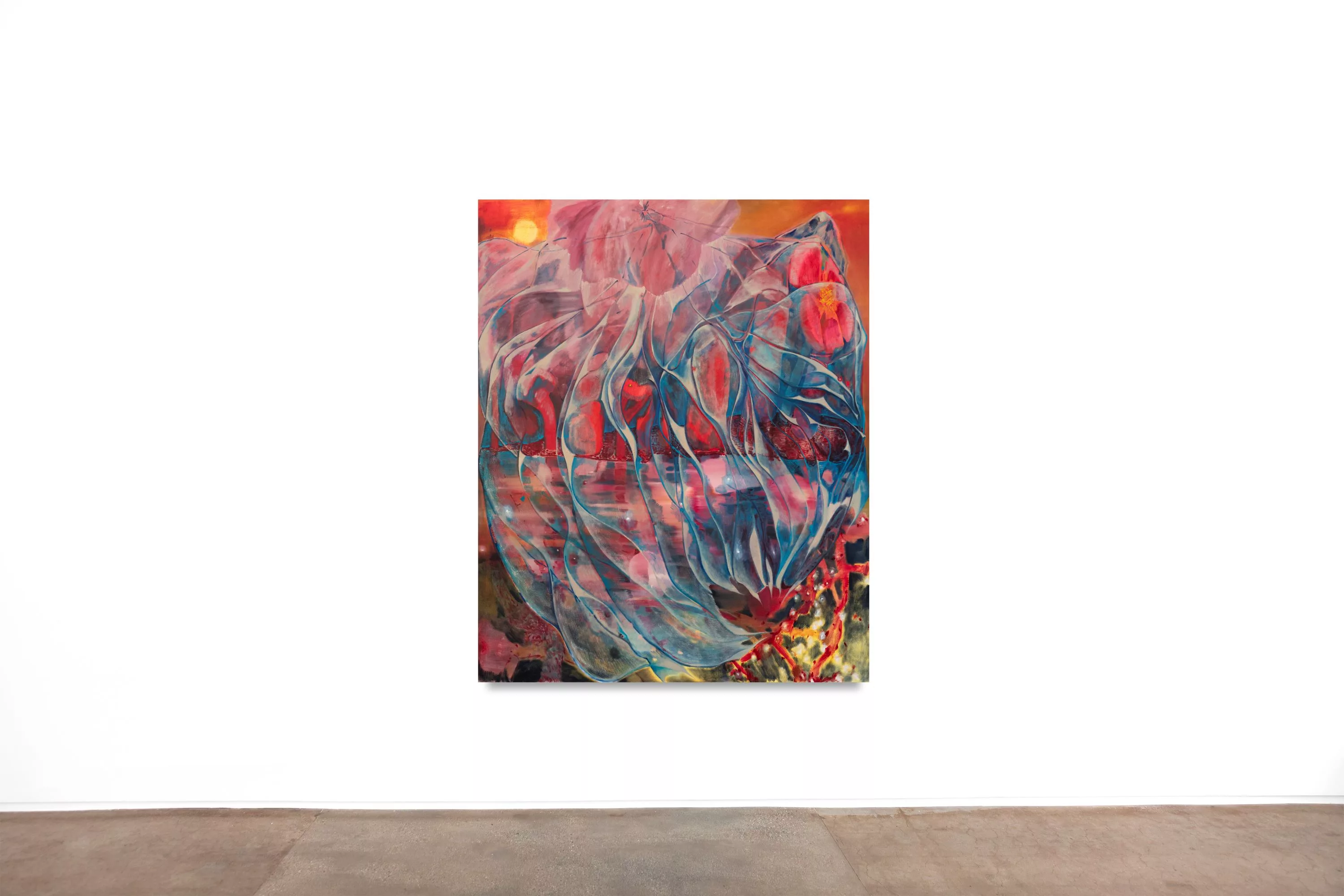
It is interesting that visual impairment and impressions of water should influence Li’s own image making. Her liquid visions – whether that be her memories of seeing through the distorting glass of a fish tank, her former anemone-like, water-dredged representations or comparing the process of painting to deep diving – return us to the “big red painting” and the impassioned perception of Ye’s blind protagonists, from Blind Massage. Although I’m not ready to be born a child again appears more like an exploding constellation in the night sky, the technique is akin to that found in Li’s other paintings: refracted, as if we’re glimpsing figures through a palpable though alien element. This partial perception adds to the erotics underpinning and embedded within the works themselves. Slithers of flesh, flashes of skin seen through a seeming seascape; hints of what was, what could be, what is beyond the veils of light-infused colours are exactly where the erotic is to be found and generated. Li gives us tantalising snatches of unidentifiable sites and sights, and therein lies the fount of pleasure. In The Pleasure of the Text Roland Barthes suggests that eroticism lies in the ‘gapes’ of a garment clasping a body; that is, the erotic is most manifest and arrived at in the furtive flashes and glimpses of parts, rather than the complete unveiling of the whole. Full exposure borders on the pornographic; whereas seeing partially – or through a glass darkly – paradoxically grants that short yet thrillingly illuminated view. In Li’s works, the privileged viewpoint then is not necessarily seeing the total and complete composition; rather, in line with Barthes, it is perceiving and previewing and encountering where the canvas ‘gapes’, unseals or ever so slightly opens up to us.
In Byung-Chul Han’s The Agony of Eros, which Li cites as an influence, the erotic is best encountered not by opening our eyes, but by closing them. Far from being an espousal of turning away from scenes deserving of our attention, shutting one’s eyes, in Han’s work, is about rejecting the nullifying and stultifying superfluity of images and the deluge of information provided by our narcissistic, capital-driven world. In closing our eyes, the imagination unfurls and the erotic grows wings; love (eros) and reason (logos) flourish. Akin to ideas found in texts by Barthes, overexposure – the full frontal view – veers into the pornographic (which for Han results in an emotionally dull, existentially dissatisfying ‘sameness’); partial sight and furtive glances of the other, however, courts our desire and the curiosity for knowledge existent beneath it. It is precisely this ‘closed’ vision that is central to Li’s work and how the artist desires us to experience them. “I always want to show the story,” Li observes. “I want to lead people along a path and through the paintings, seeing all the elements gradually; you don’t get to the erotic parts right away. That is how love is. It’s not an immediate high. It’s a story. You’re not meant to see the bodies immediately. You’re supposed to sit with the colours, and if you look carefully enough, you’ll see the body as part of a surprise. Some people might see it and others might not.”
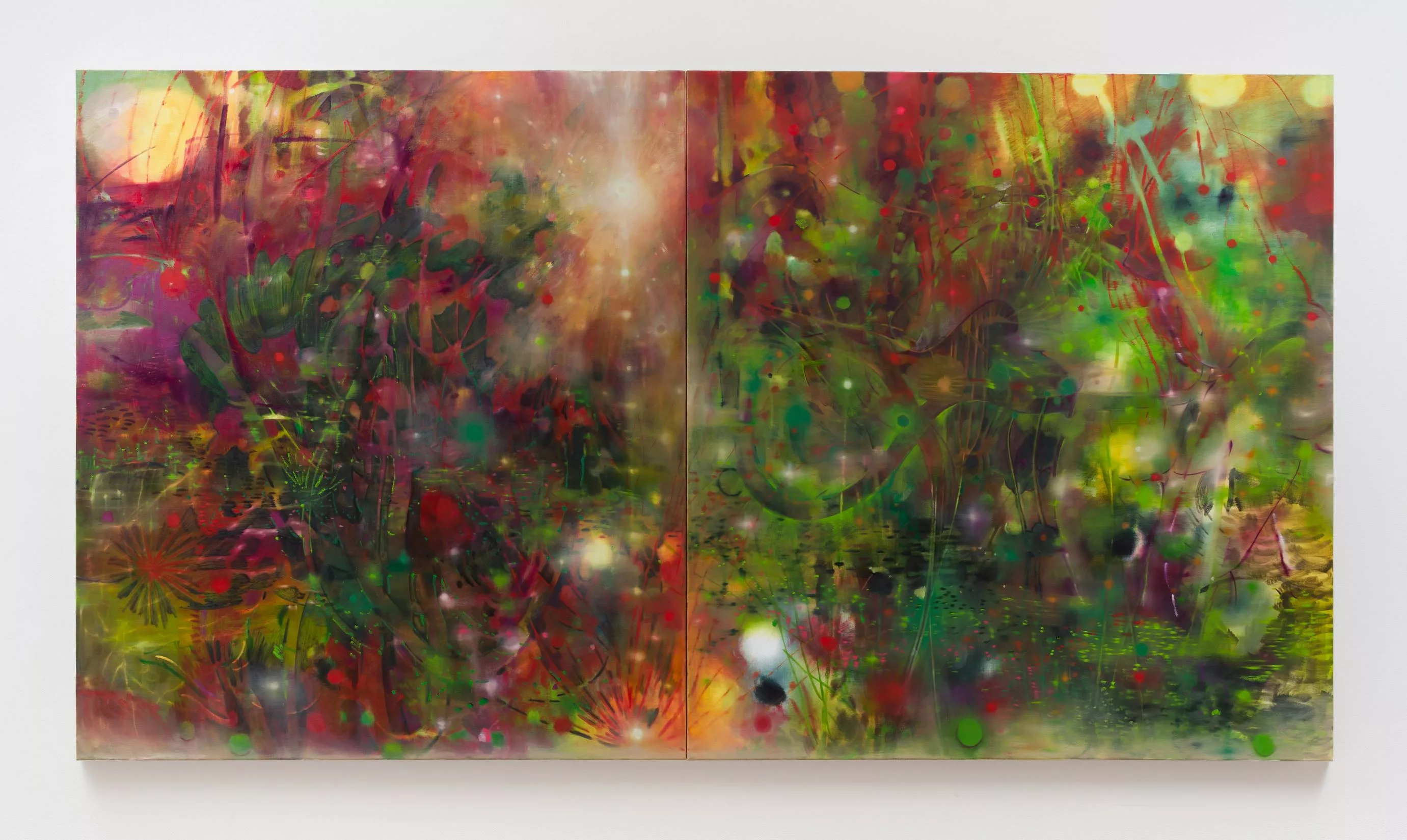
For Li, this process of concealment and gradual revealing of the secret eroticised parts in her paintings also operates as a form of protection. When discussing the other, first in regards to the erotic – again, another idea prominent in the work of Han and Barthes – then more widely in relation to specific types of othering encountered by underrepresented groups (the queer community, migrants, people of colour, the working class), Li goes back to her relationship with painting. “Some people think their paintings are like their children. But for me, my paintings are like the other. I’m always trying to learn from them. I glean all the information from the otherness of the painting. The painting itself is almost like a being. This is similar to the relationship some viewers have with the work too. When standing in front of the painting it becomes a being who you try to learn from and see. Again, it depends on how much you want to see. Some people will make excuses about not seeing the erotic parts. That’s ok, too. I want my paintings to exist like beings who can protect themselves from people who don’t understand.” In this light, Li’s paintings take on a kind of vulnerability, open to the hostile and ignorant gaze of those who reject not only the erotic import of the work, but the aesthetic process itself. That Li instinctively builds into the fabric of her paintings a form of protection – delicate though repeated filaments of tints and tones overlaying anthropomorphic shapes and biomorphic patterns in those aforementioned aqueous and nacreous environments – demonstrates the current politics around certain bodies and bodily expressions, as well as the social disconnect around “eros” and its connection to “logos”. Rather than policing these vulnerable aspects and elative experiences embedded in the work, Li still entrusts them to us, but not without a certain level of artistic retention and, above all, care.
It is noteworthy that this extra layer of protection and concealment in Li’s paintings are also ensured by the work’s literary antecedents and associations. Not only are titles for works like Breast to Breast I Face Your Hunger taken from bell hook’s poetry collection When Angels Speak of Love (2005), thereby adding an additional allusive layer to the show’s exploration of intimacy, another threshold on which to ponder and consult the erotic and poetic at play in her paintings; but Han’s aforementioned work was pivotal to crystallising Li’s title for the show, 700 Nights of Winter, as well as its resurging themes. It was Han’s book that encapsulated some of Li’s own feelings about working as an artist and its impact on her relationships: “I magically discovered Han’s book towards the end of my show in LA. After reading it, I thought ‘why didn’t I discover this earlier?!’ Everything made sense once I had, especially his description of the struggle of love in the modern world and how capitalism is destroying it, placing people in a narcissistic state as a result. But there’s another idea – the ‘inferno of the same’ – which resonated with me personally when I was preparing for the show. My girlfriend and I share the same studio, so we are always together, but we’re also always working and don’t have any time for ourselves. The show is called 700 Nights of Winter and this is partly because we worked from the afternoon until late in the morning. We were in this constant loop of darkness during winter in London, and it made me think of the inferno of the same, doing the same thing, entering the same circle each day on repeat. Han says people who search for a cure for this kind of life seek it in sex, but love, real ‘eros’, is agony, and this idea and relationship to love spoke to me.”
It is here that we come in from the cold to enjoy the warmth and protection, ecstasy and agony of Li’s own paintings. The spring after winter, the bright morning sun after those chill, laborious nights, the shining fruits de la mer of Li’s own deep-diving, demanding work; 700 Nights of Winter offers warm thoughts amidst the icy realities of life. Through her show, Li generously gifts us magnificent works that are as revelatory as they are mysterious, erotic as they are insightful, sublime as they are beautiful. Implicitly teaching us to see anew – to close our eyes to the capitalistic “sameness” of the world and open them to the deeper, rarer wealth within – the exhibition delivers us into the glowing bliss of its own painted bodies, whilst embodying new sensations, new dreams, new fluid encounters for artist and viewer alike; new zones in which all we need feel and see, is red.
Written by Hannah Hutchings-Georgiou





